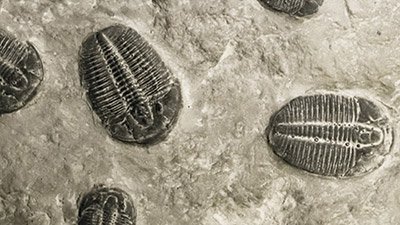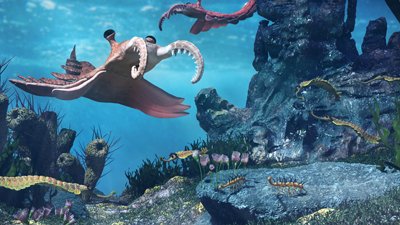
Sulphuric Fossils Give Insight On Ancient Earth
Sulfur-based life: for real? And what does Australian sandstone have to do with Mars?
News Source
In the struggle to see who can find the oldest fossils, the team of Wacey and Brasier has struck a new blow using a battery of analytical techniques to authenticate a biological origin for stromatolites from Strelley Pool, Australia. Stromatolites are finely layered dome-shaped structures found in sedimentary rocks. Those of biologic origin are created by layers of microorganisms (including some sulfur-eating bacteria) as well as the precipitated minerals and grit in which they have entombed themselves. “Such bacteria are still common today. Sulphur bacteria are found in smelly ditches, soil, hot springs, hydrothermal vents - anywhere where there's little free oxygen,” explains Oxford’s Professor Martin Brasier.
Strelley Pool’s stromatolite-containing rocks are sandwiched between layers of volcanic rock.1 Radiometric dating of these volcanic rocks has produced a date of 3.4 billion years for the trapped sedimentary rock. Therefore, if researchers can prove that their samples are really of biologic origin, they will have demonstrated that life existed at the time these Archean rock layers—among the lowest (and therefore earliest) in the Precambrian rock record—formed.
At last we have good solid evidence for life over 3.4 billion years ago. It confirms there were bacteria at this time, living without oxygen.
“At last we have good solid evidence for life over 3.4 billion years ago. It confirms there were bacteria at this time, living without oxygen,” says Brasier. It surprises many evolutionists that life evolved so “soon” after, as they contend, a devastating asteroid bombardment 3.85 billion years ago sterilized the earth by “heating the surface to molten rock and boiling the oceans into an incandescent mist.”2
The astrobiological application of their conclusion—that life evolved on an anoxic earth in less than a billion years—is that life could certainly have evolved on hostile worlds in outer space. “Could these sorts of things exist on Mars? It's just about conceivable,” says Brasier. “But it would need these approaches -- mapping the chemistry of any microfossils in fine detail and convincing three-dimensional images -- to support any evidence for life on Mars.”3
The chemical mapping and 3D-imaging Brasier speaks of are methods he used in his effort to confirm that this Strelley Pool sandstone contains microfossils of bacteria and evidence of their rock-forming activity. Modern stromatolites are an ecosystem sandwich consisting of a layer of photosynthetic cyanobacteria overlying a layer of sulfur-metabolizing bacteria. The lower tiers of bacteria interact chemically with rocky debris, creating a sort of cement tomb. These layers build up to form stromatolites.
Three-dimensional images of the Strelley Pool sandstone samples suggest the shapes of bacteria and their tubular tombs, but pictures can be deceiving. More convincing evidence of biological origin is the fact that these “microfossils” are fused to pyrite—an iron-sulfur mineral—which can form when sulfur-eating bacteria interact with iron-bearing minerals. The pyrite crystals contain lower molecular weight sulfur isotopes. Living organisms tend to “prefer” reacting with such lighter isotopes, so the researchers “interpret the pyrite crystals as the metabolic by-products of these cells.”4
“Life likes lighter isotopes, so if you have a light signature in these minerals then it looks biological,” explains Dr. David Wacey. “There are ways to get the same signature without biology, but that generally requires very high temperatures. So when you put together the light isotope signature with the fact that the pyrite is right next to the microfossils - just a couple of microns away - then it really does look like there was a whole sulphur ecosystem there.
As creationists we would not be surprised to find that the Strelley Pool sandstone contains bona-fide fossilized biological remains. We do not, however, accept the 3.4 billion year date as it not only contradicts Scriptural timetables but also is based on unprovable assumptions.
The Archean rock layers are believed by many creationist geologists to have been formed very early in the Creation week. Since microorganisms function ecologically as an interface between the inorganic and the biological, it would be no surprise to learn that God populated that early earth with these tiny mineral processors. And while larger organisms such as those found in higher rock layers needed to be buried rapidly and catastrophically to fossilize, microorganisms are a different story. In the more stable environment of the pre-Flood world, their tiny forms would have easily been buried and preserved leaving many such rocky remnants from that time for us to study.
The living stromatolites of today (found in many places but particularly in Australia and the Bahamas) appear to be very similar to fossil stromatolites. Since they survive quite nicely in our oxygenated world today, their presence in some of the lowest rock layers is not evidence that the world then had a non-oxygen atmosphere. The notion of an anoxic early earth does not survive careful geologic scrutiny but is needed by evolutionists to explain how evolving biological systems could avoid being oxidized.
Thus, the existence of these stromatolite structures in this Archean rock layer—whether they were biologically generated or not—is consistent with a biblical understanding of earth’s history. But what can actually be seen in these Strelley Pool stromatolites does not support the idea that life evolved from chemicals, does not prove that billions of years elapsed on earth with or without oxygen, and does not tell us anything about potential life on Mars. The leaps of logic made by these scientists are due to their evolutionary faith and are simply not substantiated by the observable data.
Further Reading
- Radiometric Dating: Back to Basics
- Radiometric Dating: Problems with the Assumptions
- Radiometric Dating: Making Sense of the Patterns
For More Information: Get Answers
Remember, if you see a news story that might merit some attention, let us know about it! (Note: if the story originates from the Associated Press, FOX News, MSNBC, the New York Times, or another major national media outlet, we will most likely have already heard about it.) And thanks to all of our readers who have submitted great news tips to us. If you didn’t catch all the latest News to Know, why not take a look to see what you’ve missed?
(Please note that links will take you directly to the source. Answers in Genesis is not responsible for content on the websites to which we refer. For more information, please see our Privacy Policy.)
Footnotes
- University of Oxford, “Oldest Fossils on Earth Discovered,” ScienceDaily, August 22, 2011, http://www.sciencedaily.com/releases/2011/08/110821205241.htm.
- Nicholas Wade, “Team Claims It Has Found Oldest Fossils,” The New York Times, August 21, 2011, http://www.nytimes.com/2011/08/22/science/earth/22fossil.html.
- University of Oxford, “Oldest Fossils on Earth Discovered.”
- David Wacey et al., “Microfossils of Sulphur-metabolizing Cells in 3.4-billion-year-old Rocks of Western Australia,” Nature Geoscience 4 (August 21, 2011): 698–702, doi:10.1038/ngeo1238.
Recommended Resources

Answers in Genesis is an apologetics ministry, dedicated to helping Christians defend their faith and proclaim the good news of Jesus Christ.
- Customer Service 800.778.3390
- Available Monday–Friday | 9 AM–5 PM ET
- © 2026 Answers in Genesis




